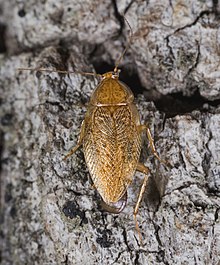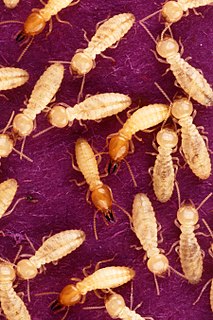
Termites are small insects that live in colonies and have distinct castes (eusocial) and feed on wood or other dead plant matter, occurring on every continent except Antarctica. Termites comprise the infraorder Isoptera, or alternatively the epifamily Termitoidae, within the order Blattodea. Termites were once classified in a separate order from cockroaches, but recent phylogenetic studies indicate that they evolved from cockroaches, as they are deeply nested within the group, and the sister group to wood eating cockroaches of the genus Cryptocercus. Previous estimates suggested the divergence took place during the Jurassic or Triassic. More recent estimates suggest that they have an origin during the Late Jurassic, with the first fossil records in the Early Cretaceous. About 3,106 species are currently described, with a few hundred more left to be described. Although these insects are often called "white ants", they are not ants, and are not closely related to ants.

Ectobiidae is a family of the order Blattodea (cockroaches). This family contains many of the smaller common household pest cockroaches, among others. They are sometimes called wood cockroaches. A few notable species include:
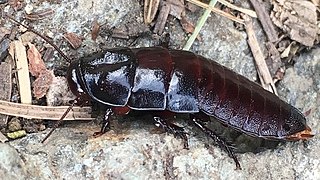
Cryptocercus is a genus of Dictyoptera and the sole member of its own family Cryptocercidae. Species are known as wood roaches or brown-hooded cockroaches. These roaches are subsocial, their young requiring considerable parental interaction. They also share wood-digesting gut bacteria types with wood-eating termites, and are therefore seen as evidence of a close genetic relationship, that termites are essentially evolved from social cockroaches.

Cockroaches are a paraphyletic group of insects belonging to Blattodea, containing all members of the group except termites. About 30 cockroach species out of 4,600 are associated with human habitats. Some species are well-known as pests.

Supella is a genus of cosmopolitan and wild cockroaches, in the family Ectobiidae: originating from Africa and the Arabian Peninsula.

The pallid bat is a species of bat that ranges from western Canada to central Mexico. It is the sole species of its genus and is closely related to Van Gelder's bat, which is sometimes included in Antrozous. Although it has in the past been placed in its own subfamily (Antrozoinae) or even family (Antrozoidae), it is now considered part of the subfamily Vespertilioninae and the tribe Antrozoini.

Lactarius pallidus, the pale milkcap, is an edible mushroom of the genus Lactarius. It is pale in colour, and found on the floor in beech or birch woodland. Its smooth cap features a particularly thick layer of flesh, and often has an incurved margin. Though generally considered edible, it is not recommended to be eaten raw. It is common in Europe, and less common in North America and Australasia.
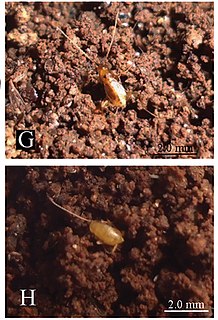
Nocticola is a genus of cockroaches in the family Nocticolidae distributed in Africa, south-east Asia and Australia. Nocticola are different from every other cockroach in that they are not infected with Blattabacterium cuenoti. This makes them the only genus in Blattodea that do not have the bacteria.

Ectobius is a genus of non-cosmopolitan cockroaches once thought native to the Old World and described by Stephens in 1835, belonging to the family Ectobiidae, subfamily Ectobiinae. The discovery of 4 ectobius cockroaches in Colorado dating to 49 Million years ago suggests the genus actually originated in North America. This genus has been subject to a number of revisions.

The Turkestan cockroach, also known as the rusty red cockroach, red runner cockroach or simply rusty red, red runner, or lat, is a primarily outdoor-dwelling cockroach native to an area from northern Africa to Central Asia. Adults measure around 3 cm (1.2 in) in length. Adult males are a brownish orange or red, are slender, and have long, yellowish wings which allow it to attract females and to glide. Adult females are dark brown to black, with cream-colored markings on the shield and a cream-colored stripe edging its wings; they are broader than males, and have short vestigial wings. Nymphs are brown in front, black on the rear, and are wingless.

Planuncus is a genus of cockroaches native to Old World described by Bohn in 2013 and belonging to the family Ectobiidae, subfamily Ectobiinae.

Planuncus tingitanus s.l. is a working title for any of the species belonging to the Planuncus tingitanus species group, of the cockroach genus Planuncus. As the exact status of some the species in this group can not be determined without more research, the whole species complex is referred to by the name of the oldest species in the group sensu lato.
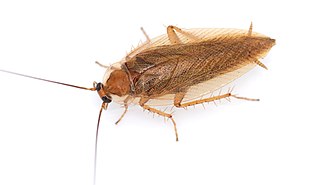
Ectobius vittiventris, the amber wood cockroach, is a species belongs to the order Blattodea. It is a species of wood cockroach originally from southern Europe. It is completely harmless to humans and does not appear as a storage pest, as it only feeds on decomposing plant material and perishes within a few days in human dwellings due to a lack of food. Its original range is south of the Alps, but this species seems to have established itself permanently north of the Alps and in southern Germany.

Stenobothrus lineatus is usually called the stripe-winged grasshopper: it is a species of grasshoppers in the family Acrididae.
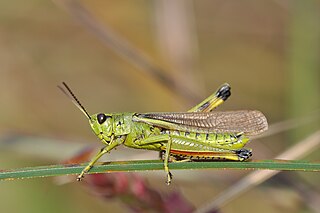
The large marsh grasshopper is a species of grasshopper belonging to the family Acrididae.

Ectobius lapponicus, also known as the dusky cockroach, is a species of cockroach found in Europe, northern Asia, the northeastern United States, and southeastern Canada.
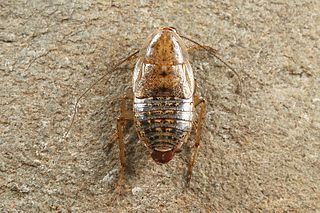
Capraiellus is a genus of non-cosmopolitan cockroaches in the family Ectobiidae.

Capraiellus panzeri is a species of non-cosmopolitan cockroach in the subfamily Ectobiinae: commonly known by its original (genus) name Ectobius panzeri.

Ectobius sylvestris, known generally as the forest cockroach or lesser cockroach, is a species of cockroach in the family Ectobiidae. It is found in Europe and Northern Asia, North America, and temperate Asia.
